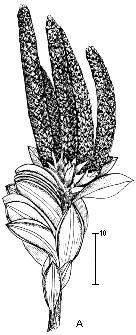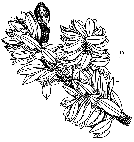
Range of Podocarpus brassii (3). New Guinea basemap from Expedia Maps.

Branch with male catkins (Kalkman 4534) (1).

B. bud scales, C. young sporophyll, D. ripe sporophyll (Kalkman 4534) (1).

Fruiting branch (1).
Common Names
"baugwa, baula [Chimbu, Waimambano], chuga [Chimbu], kaibigltuga [Minj], kaipil [Wahgi, Minj], karbuku [Komia] , maja [Mairi, Mondo], mbagua [Chimbu], tsula [Chimbu, Masul]" (1).Taxonomic notes
Silba (2) describes a variety, humilis.Description
"Trees or bushy shrubs, up to 15 m tall, often crooked and gnarled. Bark reddish brown, pale brown, fibrous, or pale grey-brown with broad and narrow longitudinal grooves. Inner bark yellow brown or pale orange-brown. Wood yellowish brown, sometimes slightly purplish. Branchlets stoutish, angular, terminal buds globose, 5-7 mm across, scales often spreading, ovate-lanceolate, 5-8 by 3-5 mm, acuminate, crested, tip curving outward. Leaves crowded, dark green, underside often glaucous and margin reddish, young ones reddish or light green with reddish margins, coriaceous, broadly lanceolate or obovate-lanceolate, 10-18(-25) by 3-7 mm when mature, but young ones often larger, acute or obtusely apiculate, narrowly cuneate at base, midrib narrow and prominent to subprominent above, rounded, broader and prominent below, margin revolute, often entire leaf concave and curved upwards. Petioles 0.5-2 mm long, flat above, crested below. Male cones axillary, solitary, cylindric, 2.5-3 by 0.3-0.7 cm, sessile, at base enveloped by a few scales, these bracts ovate-triangular, 3-6 by 2-5 mm, obtuse or acute, apical ones hook-tipped, all crested and slightly curving outward, microsporophylls (, imbricate, 3.5-4 by 1-1.5 mm, apiculus triangular or oblong, 1.5-2 mm long, acute, margin scarious, anther-cells at base, ellipsoid-ovoid, 1 mm long. Female cone solitary, axillary. Peduncle thick and fleshy, 2-9 mm long. Receptacle reddish purple, composed of 2 or 3 fleshy, fused, 5-9 by 2.5-7 mm large scales, subtended by 2 narrowly triangular, 2.5-3 by 1.5-2 mm large bracts. Ovules usually solitary. Seeds purplish or blackish when ripe, ellipsoid-globose, 7-10 by 5-6 mm, rounded at tip and base" (1).Range
New Guinea. "A species usually found in the upper montane and subalpine regions, sometimes venturing out into the alpine grasslands, or a survivor from burned subalpine shrubberies replaced by grasslands, 1750-3810 m. Flowers March - October" (1). Regional distribution is as follows (1):"WNG. Wisse Lakes, Carstensz Mts, Ilaga area, Mt. Doorman, Mt Wichmann, Lake Habbema, Star Mts.
"TNG. Sirius plateau, Mt Hagen, Kubor Range, Pengagl Creek - Mt Wilhelm area, Mt Kerigomna, Mt Otto, Mt Michael, Mt. Piora, Mt Amungwiwa.
"PAPUA. Kaguba, Ibiwara, Mt Ambua, Mt Giluwe, Mt Albert Edward, Mt Suckling."
Big Tree
Oldest
Dendrochronology
Ethnobotany
Observations
Remarks
Citations
(1) Van Royen 1979.(2) Silba 1986.
(3) Laubenfels 1988.
[Podocarpus] [Podocarpaceae] [home]
This page is from the Gymnosperm Database
URL: http://www.geocities.com/RainForest/Canopy/2285/po/po/brassii.htm
Edited by Christopher J. Earle
E-mail:earlecj@earthlink.net
Last modified on 19-Dec-98